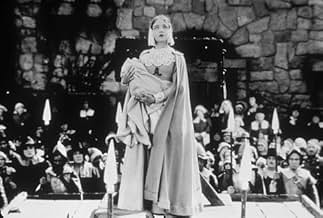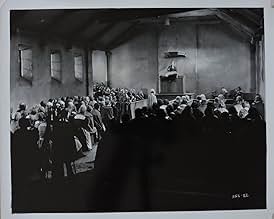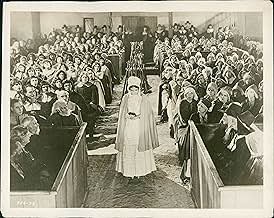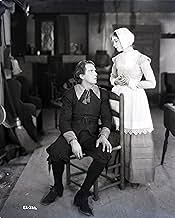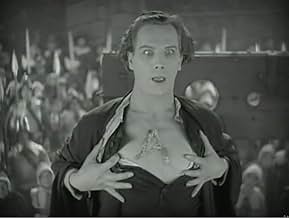IMDb RATING
7.6/10
2.1K
YOUR RATING
After having a baby out of wedlock, a young Puritan woman is pressured to reveal the name of her lover.After having a baby out of wedlock, a young Puritan woman is pressured to reveal the name of her lover.After having a baby out of wedlock, a young Puritan woman is pressured to reveal the name of her lover.
- Awards
- 1 win total
Buck Black
- Child in crowd
- (uncredited)
Nora Cecil
- Townswoman
- (uncredited)
Iron Eyes Cody
- Young Indian at Dunking
- (uncredited)
Artye Folz
- Child
- (uncredited)
Dorothy Gray
- Child
- (uncredited)
Douglas Haig
- Minor Role
- (uncredited)
Betsy Ann Hisle
- Child
- (uncredited)
Featured reviews
There just aren't enough words to describe the beautiful performances in this film....not that words are needed, then or now. Victor Seastrom's lovingly crafted scenes provide perfect visual frames for the transcendent performances of Lillian Gish and Lars Hanson. An artistic triumph for everyone concerned, and a bittersweet reminder of what was lost with the death of the art of the silent film. (The Turner restoration is alas, also bittersweet, as prints of wildly differing quality had to be "married" in order to create a substantially complete copy of the subject. Thus, viewers move from scenes that shimmer with pristine beauty to muddy, contrasty dupes. It's a tribute to the art of all concerned however, that this is not the distracting issue it might be with a lesser film. Like any work of art, you won't notice the cracks and flaws after a while if you're paying attention as you should. It's just a shame that the entire film isn't as mint-fresh as some of its scenes.)
After years of desperately wanting to see this movie I finally got hold of a copy of it. I put the DVD in the machine and waited with baited breath, was the film going to be as wonderful as the other commenters(?)had rated it? was it going to be anywhere near as good as the other Gish/Hanson/Seastrom collaboration "The Wind"? Well, the answer was that it was everything I hoped for and more. The version I saw a recording of TCM's restoration so the quality of the print veered from superb to not quite so good, but, in all honesty that did not matter as I soon got caught up in the story of Hester Prynne and the Rev. Dimmesdale. The acting was superb by all the cast, the direction was excellent and the whole setting of the movie was outstanding. It still amazes me who there are those who will not watch a silent movie, are you crazy? This version is a million miles better than the Demi Moore/Gary Oldman version made 70 years later, the chemistry between Gish and Hanson is perfect, the child actress Joyce Coad who plays Pearl, the love child, is delightful and Henry Walthall is menacing as Roger Chillingworth, Karl Dane also deserves mentioning as Master Giles in a slightly comedic role. The only downside to the movie and it had nothing to do with the movie itself was that I bought it from a guy who contacted me via IMDb and led me to believe it was his own print, I paid $52 for a TV recording off TCM. He is contacting people concerning vintage movies so beware if someone offers to get a print of that vintage movie you want to see.
I'm familiar with concept of the story, but didn't know any of the details of the film, so I was left gripped by it, waiting to see how it would all unfold. Lillian Gish is the lead, and Lars Hanson is the pastor who she has an affair with. Both give great performances on par with their work in The Wind, and the film does a wonderful job at dealing with the complexity of the religious themes. The scene where a bunch of town kids pelt Gish's young daughter with mud simply for being the child of an unwed mother is one of the more harrowing sequences I've seen. It's just brutally grim. Without having read the original source material, I have no idea how accurate the film is, but regardless it was really compelling and complex exploration of religion and hypocrisy.
It was a novel Hollywood didn't want to touch in the mid-1920s, even though the 1850 classic was brought to the screen six times earlier. The recently-established Will Hays office had its censorship fangs out. A story about a married woman who gets pregnant by a lover was cause for alarm for most movie studios.
Lilian Gish, one of silent film's major star, had long wanted to bring Nathaniel Hawthorne's 'The Scarlet Letter' in an updated version to the screen. Contracted to MGM in a three-picture deal, she convinced the studio's head of production, Irving Thalberg, she could deliver a tasteful version of Hawthorne's book without moralistic tongue-waggers complaining. With a script by Frances Marion, which follows the novel closely, MGM's August 1926's "The Scarlet Letter" has been praised as the best version of the book in a long-line of past and future movie adaptations.
Its success can be attributed to Gish herself, who portrays Hester Prynne. She hasn't heard from her husband who traveled overseas for several years from their Puritan Boston, Massachusetts, home in the mid-1600s. She becomes pregnant from a man whom she doesn't disclose the name. The Gish version departs from Hawthorne in a couple of major ways: the film begins a year earlier than the author's, showing her condemned to a stockade for leaping and dancing after her song bird escapes its cage. It's there where she meets the Reverend Arthur Dimmesdale (Lars Hanson). Also, the films unveils the love relationship between the minister and Hester, not keeping secret of who's the father of the baby.
Another reason for the movie's overall financial popularity is Swedish director Victor Sjostrom's unique directing. He allowed Gish the freedom to display her attractiveness by literally letting her hair down in a clandestine meeting with Dimmesdale in the woods, reflecting Hester's modernistic independence. Gish had the choice in selecting the director, and she picked Sjostrom because she "felt the Swedes were closer to the feelings of New England Puritans than modern Americans." She also favored Hanson as Dimmesdale from his 1924 performance in "The Saga of Gosta Berling." Hanson, who knew very little English, elected to speak his lines (it was a silent movie after all) in Swedish while Gish spoke English in scenes where they're together. Homesick actress Greta Garbo, recently arriving in America from Sweden after signing a contract with MGM, was a near daily presence on the set since she was comfortable speaking her native language with Hanson.
With two weeks of filming to go, Lillian found out her mother suffered a stroke in London and reportedly dying. Dorothy, her sister, urged her to catch the first boat to England to attend to her. In a near impossible request, Lillian asked Sjostrom she needed to leave in three days to travel by train to New York City, then on to a liner to London. The director didn't flitch. He designed an almost around-the-clock schedule to film all of Gish's parts-as long as the crew agreed to the grueling sleepless itinerary. The workers heartedly agreed.
"The Scarlet Letter" is still admired for Sjostrom's creation of an environmental rise en scene that underscored the film's characters' emotion and psychology by its pastoral recreation of a 17th century village. Even though the residents of Salem, MA, where the story takes place, were insulted by their forefathers' portrayal in the film, the American Film Institute nominated it as one of the most passionate motion pictures ever made as well as nominated Hester Prynne as one of movie's most admired heroes.
Lilian Gish, one of silent film's major star, had long wanted to bring Nathaniel Hawthorne's 'The Scarlet Letter' in an updated version to the screen. Contracted to MGM in a three-picture deal, she convinced the studio's head of production, Irving Thalberg, she could deliver a tasteful version of Hawthorne's book without moralistic tongue-waggers complaining. With a script by Frances Marion, which follows the novel closely, MGM's August 1926's "The Scarlet Letter" has been praised as the best version of the book in a long-line of past and future movie adaptations.
Its success can be attributed to Gish herself, who portrays Hester Prynne. She hasn't heard from her husband who traveled overseas for several years from their Puritan Boston, Massachusetts, home in the mid-1600s. She becomes pregnant from a man whom she doesn't disclose the name. The Gish version departs from Hawthorne in a couple of major ways: the film begins a year earlier than the author's, showing her condemned to a stockade for leaping and dancing after her song bird escapes its cage. It's there where she meets the Reverend Arthur Dimmesdale (Lars Hanson). Also, the films unveils the love relationship between the minister and Hester, not keeping secret of who's the father of the baby.
Another reason for the movie's overall financial popularity is Swedish director Victor Sjostrom's unique directing. He allowed Gish the freedom to display her attractiveness by literally letting her hair down in a clandestine meeting with Dimmesdale in the woods, reflecting Hester's modernistic independence. Gish had the choice in selecting the director, and she picked Sjostrom because she "felt the Swedes were closer to the feelings of New England Puritans than modern Americans." She also favored Hanson as Dimmesdale from his 1924 performance in "The Saga of Gosta Berling." Hanson, who knew very little English, elected to speak his lines (it was a silent movie after all) in Swedish while Gish spoke English in scenes where they're together. Homesick actress Greta Garbo, recently arriving in America from Sweden after signing a contract with MGM, was a near daily presence on the set since she was comfortable speaking her native language with Hanson.
With two weeks of filming to go, Lillian found out her mother suffered a stroke in London and reportedly dying. Dorothy, her sister, urged her to catch the first boat to England to attend to her. In a near impossible request, Lillian asked Sjostrom she needed to leave in three days to travel by train to New York City, then on to a liner to London. The director didn't flitch. He designed an almost around-the-clock schedule to film all of Gish's parts-as long as the crew agreed to the grueling sleepless itinerary. The workers heartedly agreed.
"The Scarlet Letter" is still admired for Sjostrom's creation of an environmental rise en scene that underscored the film's characters' emotion and psychology by its pastoral recreation of a 17th century village. Even though the residents of Salem, MA, where the story takes place, were insulted by their forefathers' portrayal in the film, the American Film Institute nominated it as one of the most passionate motion pictures ever made as well as nominated Hester Prynne as one of movie's most admired heroes.
I love this film for everything that it is. The story, the acting, the direction, everything about it is great.
The story revolves around Hester Prynne(Lillian Gish) and her love for the Reverrend Arthur Dimmesdale(Lars Hanson). Poor Hester is marked with the 'scarlet letter' when she gives birth to her lovechild with the bishop, and the bishop suffers on his own as his heart begins to fail on account of the guilt he feels.
The orchestration of this film helps a lot because the wonderful music helps you follow the story more and bring intensity. I love Lars Hanson's performance, he has the perfect profile for love scenes.
The story revolves around Hester Prynne(Lillian Gish) and her love for the Reverrend Arthur Dimmesdale(Lars Hanson). Poor Hester is marked with the 'scarlet letter' when she gives birth to her lovechild with the bishop, and the bishop suffers on his own as his heart begins to fail on account of the guilt he feels.
The orchestration of this film helps a lot because the wonderful music helps you follow the story more and bring intensity. I love Lars Hanson's performance, he has the perfect profile for love scenes.
Did you know
- TriviaLillian Gish learned that her mother had had a stroke in London and her sister, Dorothy Gish, urged her to get there on the first available boat. When Lillian informed director Victor Sjöström of the need to finish the film quickly, he created a shooting schedule that crammed two weeks worth of shooting into three days of non-stop work. The crew worked without complaint so that she could finish the film early and catch the earliest possible train to New York.
- Quotes
Mistress Hibbins: I am wrongly accused! Never hath my tongue been given to gossip!
The Governor: Falsehood! Her tongue hath wagged like the tail of a dog! Duck her again!
- Alternate versionsIn 2000, Turner Entertainment Co. copyrighted a restored version with a musical score written by Lisa Catarineau and Mark Northam and a running time of 98 minutes. Its previous version ran 79 minutes.
- ConnectionsFeatured in The 43rd Annual Academy Awards (1971)
- How long is The Scarlet Letter?Powered by Alexa
Details
- Release date
- Country of origin
- Official site
- Language
- Also known as
- The Scarlet Letter
- Filming locations
- Production company
- See more company credits at IMDbPro
Box office
- Budget
- $430,290 (estimated)
- Runtime1 hour 55 minutes
- Sound mix
- Aspect ratio
- 1.33 : 1
Contribute to this page
Suggest an edit or add missing content


